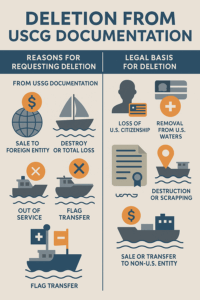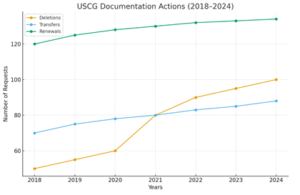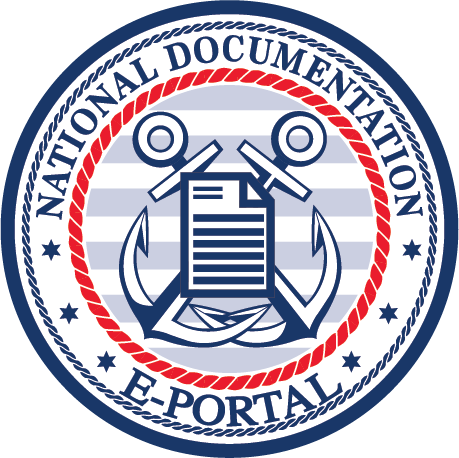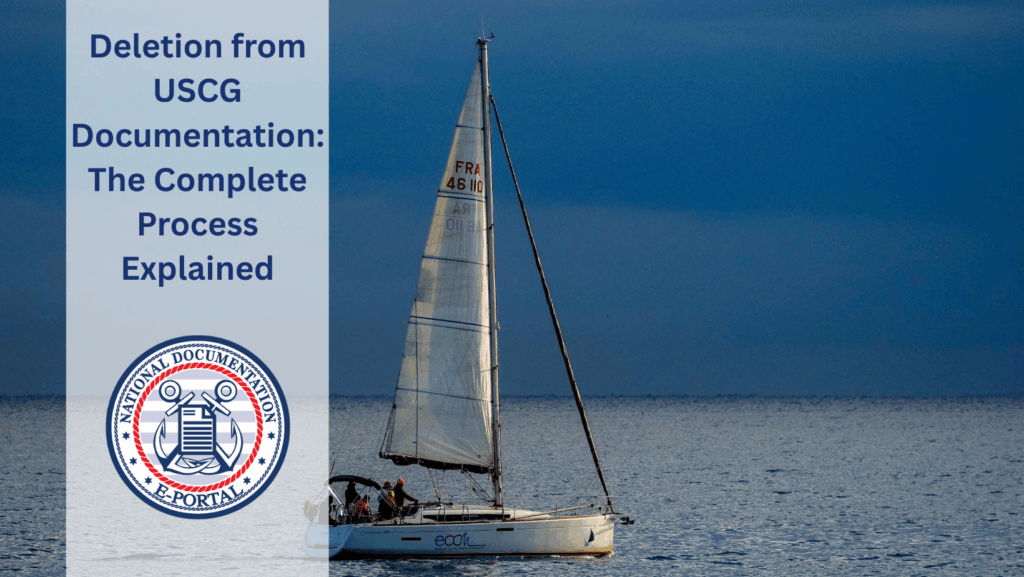Documentation is described as an integral part of owning and operating a U.S. flagged vessel, however, there are instances in which it would be required to delete (remove) a vessel from the NVDC. USCG Documentation Deletion would be to request in official capacity the removal of a vessel from the USCG Documentation database, due to sale, conversion or destruction.
Knowing how and when you ask to delete can help you avoid legal and administrative problems down the road.
What Is Deletion from USCG Documentation?
Deletion of USCG Documentation means the removal of a USCG Documented (federally documented) vessel from United States Coast Guard documentation when a vessel is no longer required to be federally documented in the United States. USCG Documentation is deleted when the vessel is sold to a foreign buyer, destroyed, or converted for non-commercial purposes.
| Purpose | Description | Key Implication |
|---|---|---|
| Sale or Transfer | Vessel sold to a foreign citizen or company. | The owner must formally terminate the vessel’s ownership and registration in the United States. |
| Destruction or Total Loss | Vessel is damaged beyond repair or dismantled. | The NVDC cancels the vessel’s documentation when the vessel can no longer operate. |
| Abandonment or Change of Use | Vessel no longer operates under U.S. documentation requirements. | The NVDC voids the registration and removes the vessel from the active registry. |
| Registration in Another Country | Vessel reflagged under a different maritime authority. | The owner surrenders the U.S. documentation to prevent dual registration. |
The process also requires that the U.S. documentation number for the vessel be permanently canceled and ownership issues with the Coast Guard settled.
Why Deletion Is Important
- Avoids Future Liability: The registered owner will not incur any future tax or liability on this vessel as a result.
- International Transfer: Deletion is compulsory when the vessel will be re-registered under a different country’s flag.
- Ownership Protection: It prevents others from using the documentation number.
- Maintains Regulatory Compliance: It ensures that all marine records are accurate and up to date under it.
They may also cause ownership disputes or lawsuits when used in international trade.
Reasons for Requesting Deletion from USCG Documentation
While a large number of dockets exist for specific reasons, in general the reasons for deletion will fall into the categories of ownership or operation.

- Sale to a Foreign Entity: The worst case for the owner is the sale of the vessel to foreign interest.
- Destroy or Totally Lose: Vessel sinks or is destroyed beyond repair.
- Out of Service: vessel is to be broken up or only used within inland waters.
- Flag Transfer: Vessel’s registration is based on commercial reasons.
Legal Basis for Deletion
- The owner also loses his/her U.S. citizenship.
- Removed from U.S. waters permanently.
- Destruction or scrapping.
- Sale or transfer to any non-U.S. entity.
The NVDC also verifies the accuracy of the vessel’s information in the National Documentation E-Portal (NDEP) to confirm ownership and eligibility, and it records each vessel that must appear in the system.
Steps to Complete a Deletion from USCG Documentation
Once the USCG completes the deletion, various administrative actions may follow, but the Coast Guard promptly removes the vessel from the national database.
Have all your documentation ready:
- Deletion Request Form (CG-1330) – the primary form for requests of this sort.
- Certificate of Documentation (COD): Return it to the NVDC.
- Prove Ownership or Sell: Bill of sale or foreign registry certificate applies.
- Supporting Affidavit – An affirmation made by the policyholder when property was destroyed, totally lost, or lost under their insurance policy.
Required Documentation for Vessel Deletion
- CG-1330 Form: Request to delete
- COD: Confirmation of vessel identity
- Bill of Sale: confirms transfer of ownership
- Affidavit of Loss: Vessel has been confirmed as totally destroyed.
Complete the CG-1330 Form
The form should include, at minimum, within:
- Official vessel name and number.
- Reason for deletion.
- The name, address, and signature of the owner.
- Date and nature of sale or loss.
To avoid processing delays or other issues, this information should correspond with that contained within the NVDC’s records.
Submit the Request to the NVDC
Send all the required paperwork and fees to the National Vessel Documentation Center in West Virginia, as incomplete applications are the most common reason for processing delays.
Receive Confirmation of Deletion
After all of those steps are complete, the NVDC issues an Official Deletion Certificate that shows the vessel is no longer registered in the U.S. and the vessel may be re-registered and/or disposed of in accordance with law.
While the NVDC processes applications in two to six weeks, demand can cause applications to take longer.
Deletion vs. Transfer vs. Renewal
The deletion from USCG Documentation, Transfer of Ownership, and Renewal of Documentation are separate processes.

- The document’s purpose was to remove the vessel from the registry, assign it to the new U.S. citizen, and extend the documentation’s time period.
- The number of deletions increased greatly post 2020 due to sales of foreign vessels and de-registrations.
- Transfers became more stable, signaling a domestic ownership exchange rate.
- The most consistent renewals suggest that a large percentage of documented vessels remained in service.
This data suggests that deletions in the USCG documentation file increased as international sales of the vessel increased.
Common Challenges in the Deletion from USCG Documentation Process
Deleting a vessel can be straightforward, but administrative or legal issues can delay or even block the request.
- Missing Original COD: The Original Certificate of Documentation has not been returned.
- Incomplete Form Fields. Missing signatures or incorrect vessel details.
- Unverified Ownership: There are no records of ownership transfer.
- Unresolved Liens or Mortgages: The NVDC cannot delete vessels that remain encumbered by liens.
| Issue | Effect | Resolution |
|---|---|---|
| Unreturned COD | Processing delay | Submit replacement affidavit |
| Incomplete details | Application rejection | Review before submission |
| Active lien | Legal hold | Obtain lien release |
| Missing proof of sale | Ownership dispute | Attach notarized bill of sale |
If you have full and properly notarized documents before sending, this should cause no difficulties.
Practical Tips for a Smooth Deletion from USCG Documentation
- No Outstanding Liens Must Be Confirmed: Check with the lender or lienholder for verification that the property has no liens.
- Save a copy of everything you send and everything you receive.
- Notify Insurance and Lenders: Inform your insurance and lenders about the deletion.
- Follow up with the NVDC: If you do not get written confirmation in six weeks, contact the NVDC on the status of your application.
Tips and Benefit
To keep the process organized and avoid delays, check for any existing liens or restrictions before submitting the request. Keep copies of all documents in case you need to re-register the vessel. When applicable, notify any third parties so you can prevent administrative issues and keep them informed of changes. Track all submitted documents to ensure you receive the confirmation promptly.
Deletion from USCG Documentation Due to Sale Abroad
The owner of a U.S.-documented yacht sold it to a Spanish buyer and submitted Form CG-1330, the original Certificate of Documentation (COD), and a notarized bill of sale to request deletion from the United States Coast Guard (USCG) Documentation system.
Outcome:
- The NVDC approved the deletion within four weeks.
- The Spanish buyer registered the yacht with Spain’s maritime authority.
- The American owner no longer faces future taxes or legal liability for the vessel.
It is also an example of the importance of maintaining accurate records in international information exchanges.
Legal and Regulatory Framework
The Coast Guard governs vessel deletion under 46 CFR Part 67, the section of the Code of Federal Regulations that covers vessel documentation.
These keep intact documents preserving federal maritime records as well as maritime conveyancing laws.
Ensuring Proper Closure of Your Vessel’s Federal Record
National Documentation E-Portal of divesting the vessel of USCG Documentation is to submit a Deletion from USCG Documentation to the USCG in compliance with regulations to avoid future liability.

